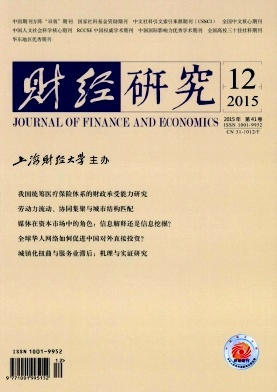异质性风险偏好、市场摩擦与自贸区金融创新的消费和投资效应——基于Diamond世代交叠模型的理论分析
财经研究 2015 年 第 41 卷第 12 期, 页码:40 - 50
摘要
参考文献
摘要
文章以个体跨期最优化行为为基础,从居民异质性风险偏好和市场摩擦视角考察了我国自贸区金融创新的消费、储蓄与投资效应,得出如下的结论:首先,中国自贸区的金融创新将引发境内外居民和投资者的储蓄和投资跨境"局部转移"或"全部转移",其转移的规模和方向取决于内外资金融企业及市场的绝对和相对投融资效率。其次,自贸区的金融创新将有效提高社会中退休群体的消费水平,对年轻群体消费、储蓄和投资的影响则取决于代表性个体的异质性风险偏好:如果代表性个体是风险厌恶、风险中性和风险偏好的,则金融创新将使年轻群体的消费量增加、不变和减少,储蓄量和投资量减少、不变和增加,储蓄转化为资本积累的规模减少、不变和增加。最后,政府应依据内外资金融企业和市场的相对投融资效率来确定金融创新的速度、深度和时序,以减小金融创新的"转移效应"对实体经济和社会稳定的强烈冲击。
[1] 巴曙松,华中炜,朱元倩.利率市场化的国际比较:路径、绩效与市场结构[J].华中师范大学学报(人文社会科学版),2012,(5):33-46.
[2] 巴曙松,严敏,王月香.我国利率市场化对商业银行的影响分析[J].华中师范大学学报(人文社会科学版), 2013,(4):27-37.
[3] 陈炳才.人民币利率市场化改革的利益影响分析[J].证券,2014,(2):21-28.
[4] 焦武.上海自贸区金融创新与资本账户开放——兼论人民币国际化[J].上海金融学院学报,2013,(6):9-17.
[5] 史宝平.利率市场化:国际比较与中国的时机选择[J].国际金融研究,2003,(12):20-26.
[6] 孙杰.跨境结算人民币化还是人民币国际化?[J].国际金融研究,2014,(4):39-49.
[7] 武剑.利率市场化进程中的利率风险管理[J].财经科学,2003,(2):58-63.
[8] Allen F, Gale D. Financial contagion[J]. Journal of Political Economy, 2000, 108(1): 1-33.
[9] Altug S, Miller R A. Household choices in equilibrium[J]. Econometrica, 1990, 58(3): 543-570.
[10] Antràs P, Helpman E. Global sourcing[J]. Journal of Political Economy,2004,112(3): 552-580.
[11] Antràs P, Caballero R J. Trade and capital flows: A financial frictions perspective[R]. NBER Working Paper No.13241, 2007.
[12] Arrow K J.The theory of risk aversion[A]. Arrow K J. Aspects of the theory of risk-bearing[C]. Helsinki:Yrjo Jahnssonin Saatio, 1965.
[13] Bardhan P, Kletzer K. Credit markets and patterns of international trade[J]. Journal of Development Economics, 1987, 27(1-2): 57-70.
[14] Boz E. Can miracles lead to crises? The role of optimism emerging market crises[R]. IMF Working Paper No.07/223, 2007.
[15] Boz E, Mendoza E G. Financial innovation, the discovery of risk, and the U.S. credit crisis[J]. Journal of Monetary Economics, 2014, 62: 1-22.
[16] Boz E, Daude C, Durdu B. Emerging market business cycles revisited: Learning about the trend[J]. Journal of Monetary Economics, 2011, 58(6): 616-631.
[17] Diamond P A. National debt in a neoclassical growth model[J]. American Economic Review, 1965, 55(5): 1126-1150.
[18] Diamond D, Dybvig P. Bank runs, deposit insurance, and liquidity[J]. Journal of Political Economy, 1983, 91(3): 401-419.
[19] Dubois P. Consumption insurance with heterogeneous preferences: Can sharecropping help complete markets?[R]. Econometric Society World Congress 2000 Contributed Paper, 2000.
[20] Friedman M, Savage L J. The utility analysis of choices involving risk[J]. Journal of Political Economy, 1948, 56(4): 279-304.
[21] Obstfeld M, Kenneth R. Exchange rate dynamics redux[J]. Journal of Political Economy, 1995, 103(3): 624-660.
[22] Pratt J W. Risk aversion in the small and in the large[J]. Econometrica, 1964, 32(1-2): 122-136.
[23] Rossi-Hansberg E. A spatial theory of trade[J]. American Economic Review, 2005, 95(5): 1464-1491.
[24] Tobin J. The theory of portfolio selection[A]. Hahn F H, Brechling F P R. The theory of interest rates[C]. London: Macmillan, 1965.
[25] Townsend R M. Risk and insurance in village India[J]. Econometrica, 1994, 62(3): 539-591.
[2] 巴曙松,严敏,王月香.我国利率市场化对商业银行的影响分析[J].华中师范大学学报(人文社会科学版), 2013,(4):27-37.
[3] 陈炳才.人民币利率市场化改革的利益影响分析[J].证券,2014,(2):21-28.
[4] 焦武.上海自贸区金融创新与资本账户开放——兼论人民币国际化[J].上海金融学院学报,2013,(6):9-17.
[5] 史宝平.利率市场化:国际比较与中国的时机选择[J].国际金融研究,2003,(12):20-26.
[6] 孙杰.跨境结算人民币化还是人民币国际化?[J].国际金融研究,2014,(4):39-49.
[7] 武剑.利率市场化进程中的利率风险管理[J].财经科学,2003,(2):58-63.
[8] Allen F, Gale D. Financial contagion[J]. Journal of Political Economy, 2000, 108(1): 1-33.
[9] Altug S, Miller R A. Household choices in equilibrium[J]. Econometrica, 1990, 58(3): 543-570.
[10] Antràs P, Helpman E. Global sourcing[J]. Journal of Political Economy,2004,112(3): 552-580.
[11] Antràs P, Caballero R J. Trade and capital flows: A financial frictions perspective[R]. NBER Working Paper No.13241, 2007.
[12] Arrow K J.The theory of risk aversion[A]. Arrow K J. Aspects of the theory of risk-bearing[C]. Helsinki:Yrjo Jahnssonin Saatio, 1965.
[13] Bardhan P, Kletzer K. Credit markets and patterns of international trade[J]. Journal of Development Economics, 1987, 27(1-2): 57-70.
[14] Boz E. Can miracles lead to crises? The role of optimism emerging market crises[R]. IMF Working Paper No.07/223, 2007.
[15] Boz E, Mendoza E G. Financial innovation, the discovery of risk, and the U.S. credit crisis[J]. Journal of Monetary Economics, 2014, 62: 1-22.
[16] Boz E, Daude C, Durdu B. Emerging market business cycles revisited: Learning about the trend[J]. Journal of Monetary Economics, 2011, 58(6): 616-631.
[17] Diamond P A. National debt in a neoclassical growth model[J]. American Economic Review, 1965, 55(5): 1126-1150.
[18] Diamond D, Dybvig P. Bank runs, deposit insurance, and liquidity[J]. Journal of Political Economy, 1983, 91(3): 401-419.
[19] Dubois P. Consumption insurance with heterogeneous preferences: Can sharecropping help complete markets?[R]. Econometric Society World Congress 2000 Contributed Paper, 2000.
[20] Friedman M, Savage L J. The utility analysis of choices involving risk[J]. Journal of Political Economy, 1948, 56(4): 279-304.
[21] Obstfeld M, Kenneth R. Exchange rate dynamics redux[J]. Journal of Political Economy, 1995, 103(3): 624-660.
[22] Pratt J W. Risk aversion in the small and in the large[J]. Econometrica, 1964, 32(1-2): 122-136.
[23] Rossi-Hansberg E. A spatial theory of trade[J]. American Economic Review, 2005, 95(5): 1464-1491.
[24] Tobin J. The theory of portfolio selection[A]. Hahn F H, Brechling F P R. The theory of interest rates[C]. London: Macmillan, 1965.
[25] Townsend R M. Risk and insurance in village India[J]. Econometrica, 1994, 62(3): 539-591.
引用本文
王根蓓, 许淑君. 异质性风险偏好、市场摩擦与自贸区金融创新的消费和投资效应——基于Diamond世代交叠模型的理论分析[J]. 财经研究, 2015, 41(12): 40–50.
导出参考文献,格式为:





 8761
8761  4207
4207

